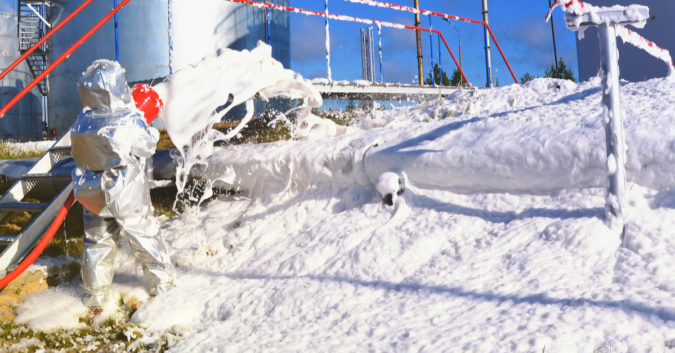There are currently 3 primary ways for disposing of per- and polyfluoroalkyl substances (PFAS), the dangerous chemicals used to make firefighting foam and a host of other consumer products: landfilling, wastewater treatment, and incineration.
According to a new study by scientists at the non-profit Environmental Working Group (EWG), none of those methods are effective. More often than not, PFAS waste disposal only increases contamination.
PFAS refers to a group of some 5,000 different fluorinated chemicals favored by industry for their non-stick, non-corrosive properties. While seemingly useful in certain consumer products, these compounds are confirmed toxins, causing thyroid problems, birth defects, and cancer.
PFAS are used in everything from non-stick cooking pans to firefighting foam, and thanks to decades of rampant industrial production they can be found throughout the environment — in the soil, the air, drinking water sources, and even our own bodies.
It’s been estimated that PFAS exists at some level in the blood of 97% of Americans.
How to Destroy ‘Forever Chemicals’
PFAS compounds get the nickname “forever chemicals” because they do not appear to break down in nature and instead build up in the body over time, causing multiple types of cancer.
So, as science catches up, so does the need for an effective disposal method. The problem, according to a study published in the journal Chemosphere, is that traditional waste disposal methods only create a cycle of contamination.
Tasha Stoiber, Ph.D., primary author of the study, told the EWG:
“The three common ‘disposal’ options for getting rid of PFAS do not eliminate these contaminants but rather end up just returning either the same chemicals or their byproducts back into the environment. PFAS disposal is really just another step in the contamination cycle.”
Consumer products containing PFAS — such as food packaging, non-stick skillets, and stain-resistant fabrics — leach into landfills over time. The other primary disposal options — wastewater treatment and incineration — only relocate PFAS loads between sites.
With wastewater treatment, PFAS-containing sludge and waste may be moved to landfills or even applied to agricultural fields, where it can contaminate soil, groundwater, and crops at even higher concentrations than before the waste was treated. Some wastewater sludge may be incinerated, which is a third and still problematic option for disposal.
Incineration on its own is a harmful process that generates pollution and greenhouse gases. When you throw PFAS into the mix, you don’t actually destroy the intensely strong chemical bonds that make PFAS compounds so resilient — you merely disperse them around the incineration site.
This phenomenon was the subject of a recent investigation by The Intercept, which found that an incinerator located in upstate New York — one that had formerly burned PFAS-containing firefighting foam — was only contaminating its own neighborhood.
Researchers from Bennington College identified 10 different PFAS compounds in the soil and water around the incineration facility, which is just 200 meters from a public-housing complex home to more than 70 families.
Monitor, Capture, Research
The Chemosphere study argues that this massive process of waste disposal only creates a cycle of contamination, from which little-to-no PFAS waste is actually destroyed or safely discarded.
Vice President for Science Investigations at EWG Olga V. Naidenko, Ph.D., said in a press release:
“The disposal of PFAS can cause environmental pollution, which disproportionately affects people and communities near the waste disposal sites. States, the EPA, and waste management companies must take strong action to protect fence-line communities from harmful exposures to PFAS.”
The Chemosphere paper does offer some recommendations for addressing the problem:
- Capture all liquid wastes from landfills and keep them on site.
- Monitor PFAS contamination at and around disposal sites.
- Enact stronger public health policies to protect affected communities.
- Limit the use of PFAS or ban them altogether.
- Research incineration processes and advanced remediation technologies.
Some of these goals are more realistic than others, but given the “forever” nature of PFAS compounds — in the sense that they do not break down on their own — the urgency to find a viable solution grows every single day.
If you worked with PFAS-containing foam as a firefighter and were later diagnosed with cancer, call (800) 995-1212 today. You may be eligible for PFAS compensation.
